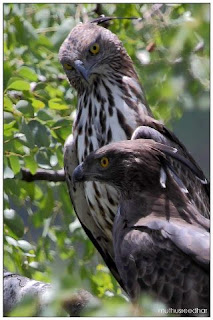 |
| Brown Hawk Owl by Prayut Mandal |
Some of the bird species that arrive here are osprey, black redstart, wagtails, pipits, larks, greenish warbler, Hume's warbler, Sulfur Bellied warbler, Gray Lag Geese, Eurasian Wigeon, Common Pochard, Coot, Gadwall, Red Crested Pochard, Brahminy Duck, Gargany, Northern Pintail and Shovellor. The resident ducks seen here are the lesser whistling teal, comb duck, and cotton pygmy goose and sometimes the spot billed duck.
Some of the other interesting birds can be seen here. We have seen Golden oriole, black headed oriole, Jerdon's leaf bird, gold fronted leaf bird, barred button quail, jungle bush quail, Tickell's thrush, Long tailed shrike, plum headed parakeet, chestnut shouldered petronia, wire tailed swallow, gray headed and coppersmith barbett, black rumped flame back, white naped woodpecker, yellow crowned woodpecker, scaly breasted munia, large cuckoo shrike, honey buzzard and paddyfield pipit. The surroundings are habitat of Indian courser, ashy crowned finch lark, rufous tailed lark, southern gray shrike, tawny pipit, Indian bush lark, Syke's lark, blue rock thrush and many more.
The Dumna Road and Nature Reserve and nearby villages are the best plac ein Jabalpur for bird watching. Many birders visit Kanha, Bandhavgarh and Pench Tiger Reserve via Jabalpur. They usually stop to see the beautiful Marble Rocks, a visit to Dumna Nature Reserve will add much fun to travel in this city. The visit can be arranged by hotels in Jabalpur City which provide travel services. There are three rooms available at Dumna Nature Reserve. Plans are in process to set up three luxury tents as well for accommodation by MPTDC.
In order to visit Dumna one has to drive or taxi down half way to the airport. The whole package can be arranged by the hotel you are staying at.















































